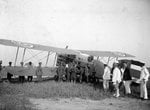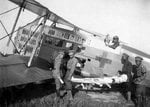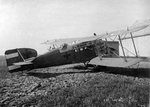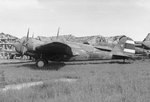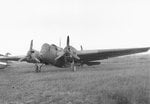In February 1911 the Belgian pilot Charles Van Den Born displayed the first aircraft in Thailand at the Sa Pathum Horse Racing Course. The Thai authorities were impressed enough by the display that on 28 February 1912 they dispatched three officers to learn to fly in France, a leading aviation country. The three officers (Major Luang Sakdi Sanlayawut (Sunee Suwanprateep), Captain Luang Arwut Sikikorn (Long Sinsuk) and First Lieutenant Tip Ketuthat) learned to fly and on 2 November 1913 returned to Thailand with eight aircraft (four Breguets and four Nieuports). They are today regarded as the forefathers of the Royal Thai Air Force. In March of the next year they moved from Sa Pathum airfield to Don Muang. The Ministry of Defence put the early air force under the control of the Army Engineer Inspector General Department. Prince Purachatra, Commander of the Army Engineers, and his brother Prince Chakrabongse Bhuvanath were instrumental in the development of the army's Royal Aeronautical Service, a forerunner to the Air Force.
During the French-Thai War, the Thai Air Force scored several air-to-air-victories against the Vichy France Armée de l'Air. During World War II the Thai Air Force supported the Royal Thai Army in its occupation of the Burmese Shan States as allies of the Japanese in 1942 and defended Bangkok from allied air raids during the latter part of the war. Some RTAF personnels also assisted the anti-Japanese resistance. After World War II, the Thai Air Force sent three C-47s to support the United Nations in Korean War. The victorious Wings Unit, operating C-47, also joined the US Force in Vietnam War. Along the border, Thai Air Force launched many campaign against the communists, such as Ban Nam Ta Airfield Raid in Laos, and clashes between Thai and Vietnamese troops along the Thai-Cambodian border. When the cold war ended, the Thai Air Force participated in Operation Border Post 9631 along the Thai-Burmese border in 1999, and launched the evacuation of Thais and foreigners during the 2003 Phnom Penh riots in Cambodia.
During the French-Thai War, the Thai Air Force scored several air-to-air-victories against the Vichy France Armée de l'Air. During World War II the Thai Air Force supported the Royal Thai Army in its occupation of the Burmese Shan States as allies of the Japanese in 1942 and defended Bangkok from allied air raids during the latter part of the war. Some RTAF personnels also assisted the anti-Japanese resistance. After World War II, the Thai Air Force sent three C-47s to support the United Nations in Korean War. The victorious Wings Unit, operating C-47, also joined the US Force in Vietnam War. Along the border, Thai Air Force launched many campaign against the communists, such as Ban Nam Ta Airfield Raid in Laos, and clashes between Thai and Vietnamese troops along the Thai-Cambodian border. When the cold war ended, the Thai Air Force participated in Operation Border Post 9631 along the Thai-Burmese border in 1999, and launched the evacuation of Thais and foreigners during the 2003 Phnom Penh riots in Cambodia.
I must confess I am a little bit dissapointed about this thread; I have been looking for pictures and information for long time, with a very poor results. However I have been able to find some pictures very interesting that deserve to be showed in their own thread. I promise I will try to provide you with more and better pictures, but by the moment this is all I have.

